Facing the dual challenges of fluctuating raw material supply and environmental pressure in the global new energy industry chain, China's lithium battery recycling enterprises are embracing development opportunities. Through its advanced crushing and recycling technology, Jiangxi Mingxin extracts carbon-lithium-cobalt powder from waste lithium batteries. This powder not only realizes the circular utilization of key metal resources but also demonstrates significant market competitiveness in terms of price, providing a new path for enhancing the resilience of the power battery supply chain.
Resource Regeneration Value Driven by Technology
Jiangxi Mingxin adopts dry physical crushing and high-voltage electrostatic separation technology, which has achieved a metal recovery rate of over 95% in the circuit board recycling field. This mature technology is now effectively applied in the lithium battery recycling sector. The carbon-lithium-cobalt powder produced through this process mainly contains key battery metal elements such as cobalt and lithium, with a cobalt content that meets industry mainstream standards. It can be directly used as a raw material supplement for the production of ternary cathode materials.
Against the backdrop of the Democratic Republic of the Congo (DRC) extending the cobalt export ban, which has caused a 100,000-ton contraction in global cobalt supply, the value of this recycled carbon-lithium-cobalt powder has become increasingly prominent. Industry data shows that in September 2025, the spot price of domestic primary cobalt with a purity of 99.8% reached 264,000 - 276,000 yuan/ton, while the market quotation for lithium cobalt oxide electrode powder (lithium content ≥ 6.5%) in the same period was 121,300 - 122,600 yuan/ton. The cost advantage of recycled materials is significant. This price gap forms a strong market appeal for downstream battery manufacturers struggling with high raw material costs.
Market Logic Behind Price Advantages
The current lithium battery recycling market presents distinct structural characteristics: the procurement cost of upstream waste batteries accounts for 60%-80% of the total production cost, while the prices of downstream recycled products such as black powder (carbon-lithium-cobalt powder) remain under pressure. By optimizing the crushing and separation process, Jiangxi Mingxin has reduced unit energy consumption and stabilized the cobalt recovery rate at an industry-leading level, enabling its carbon-lithium-cobalt powder to have dual advantages in quotation.
From the perspective of the price system, recycled cobalt products adopt a discount coefficient pricing model. Currently, the cobalt salt discount coefficient for lithium cobalt oxide electrode powder is 75.5%, significantly higher than the industry average. Calculated based on this, the cost of recycled materials with the same cobalt content is approximately 24.5% lower than that of primary cobalt. This does not even include the environmental protection costs and transportation costs in the primary material mining process. Especially amid the intensified fluctuations in the battery raw material market caused by three consecutive declines in lithium carbonate prices, the price stability of recycled carbon-lithium-cobalt powder is more favored by downstream enterprises.
Development Driven by Both Policy and Market
The restructuring of the global supply chain has created a favorable environment for the lithium battery recycling industry. The EU Battery Regulation requires that the proportion of recycled cobalt in battery raw materials should not be less than 20% by 2030, while China's "dual carbon" policy continues to strengthen resource circular utilization. Jiangxi Mingxin's carbon-lithium-cobalt powder products precisely align with this development trend. The environmental protection standards of "no dust pollution and no water consumption" achieved in its production process meet the strict requirements for green production at home and abroad.
Although the lithium battery recycling market faced challenges such as weak supply and demand and profit inversion in the first half of 2025, enterprises with technological advantages have demonstrated anti-cyclical capabilities. As the number of retired batteries from new energy vehicles increases year by year and the demand for waste battery recycling in the energy storage sector is released, the market scale of carbon-lithium-cobalt powder, as a key link in the circular economy, is expected to maintain an annual growth rate of more than 15% in the next five years. Through continuous process optimization, Jiangxi Mingxin is transforming the price advantage of recycled materials into market competitiveness, providing a local solution for the sustainable development of the global power battery supply chain.


